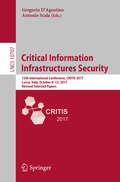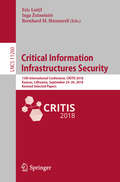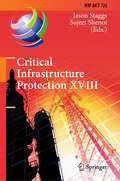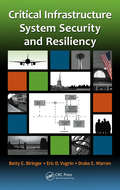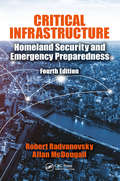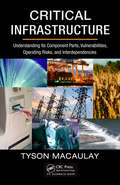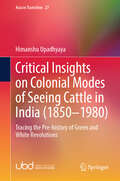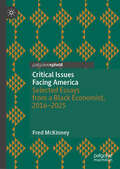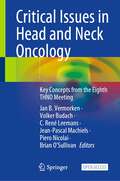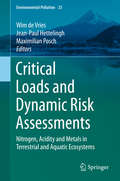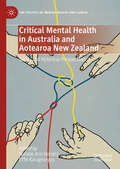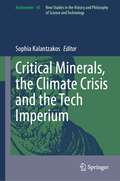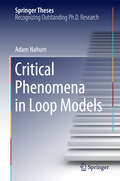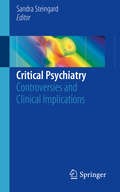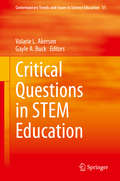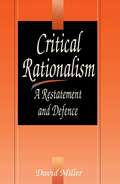- Table View
- List View
Critical Information Infrastructures Security: 12th International Conference, Critis 2017, Lucca, Italy, October 8-13, 2017, Revised Selected Papers (Lecture Notes in Computer Science #10707)
by Gregorio D'Agostino Antonio ScalaThis book constitutes revised selected papers from the 12th International Conference on Critical Information Infrastructures Security, CRITIS 201, held in Lucca, Italy, in October 2017. The 21 full papers and 4 short papers presented were carefully reviewed and selected from 63 submissions. They present innovative research and explore new challenges in the field of critical information infrastructures protection (C(I)IP) and deal with multi-disciplinary approaches to relevant C(I)IP problems.
Critical Information Infrastructures Security: 13th International Conference, CRITIS 2018, Kaunas, Lithuania, September 24-26, 2018, Revised Selected Papers (Lecture Notes in Computer Science #11260)
by Eric Luiijf Inga Žutautaitė Bernhard M. HämmerliThis book constitutes revised selected papers from the 13th International Conference on Critical Information Infrastructures Security, CRITIS 2018, held in Kaunas, Lithuania, in September 2018.The 16 full papers and 3 short papers presented were carefully reviewed and selected from 61 submissions. They are grouped in the following topical sections: advanced analysis of critical energy systems, strengthening urban resilience, securing internet of things and industrial control systems, need and tool sets for industrial control system security, and advancements in governance and resilience of critical infrastructures.
Critical Infrastructure Protection XVII: 17th IFIP WG 11.10 International Conference, ICCIP 2023, Arlington, VA, USA, March 13–14, 2023, Revised Selected Papers (IFIP Advances in Information and Communication Technology #686)
by Sujeet Shenoi Jason StaggsThe information infrastructure – comprising computers, embedded devices, networks and software systems – is vital to operations in every sector: chemicals, commercial facilities, communications, critical manufacturing, dams, defense industrial base, emergency services, energy, financial services, food and agriculture, government facilities, healthcare and public health, information technology, nuclear reactors, materials and waste, transportation systems, and water and wastewater systems. Global business and industry, governments, indeed society itself, cannot function if major components of the critical information infrastructure are degraded, disabled or destroyed. Critical Infrastructure Protection XVII describes original research results and innovative applications in the interdisciplinary field of critical infrastructure protection. Also, it highlights the importance of weaving science, technology and policy in crafting sophisticated, yet practical, solutions that will help secure information, computer and network assets in the various critical infrastructure sectors. Areas of coverage include: Themes and IssuesSmart Grid Risks and ImpactsNetwork and Telecommunications Systems SecurityInfrastructure SecurityAutomobile Security This book is the seventeenth volume in the annual series produced by the International Federation for Information Processing (IFIP) Working Group 11.10 on Critical Infrastructure Protection, an international community of scientists, engineers, practitioners and policy makers dedicated to advancing research, development and implementation efforts focused on infrastructure protection. The book contains a selection of eleven edited papers from the Seventeenth Annual IFIP WG 11.10 International Conference on Critical Infrastructure Protection, which was held at SRI International, Arlington, Virginia, USA in the spring of 2023. Critical Infrastructure Protection XVII is an important resource for researchers, faculty members and graduate students, as well as for as well as for policy makers, practitioners and other individuals with interests in homeland security.
Critical Infrastructure Protection XVIII: 18th IFIP WG 11.10 International Conference, ICCIP 2024, Arlington, VA, USA, March 18–19, 2024, Proceedings (IFIP Advances in Information and Communication Technology #725)
by Sujeet Shenoi Jason StaggsThe cyber infrastructure – comprising computers, embedded devices, networks and software systems – is vital to operations in every sector: chemicals, commercial facilities, communications, critical manufacturing, dams, defense industrial base, emergency services, energy, financial services, food and agriculture, government facilities, healthcare and public health, information technology, nuclear reactors, materials and waste, transportation systems, and water and wastewater systems. Global business and industry, governments, indeed society itself, cannot function if major components of the critical infrastructure are degraded, disabled or destroyed.Critical Infrastructure Protection XVIII describes original research results and innovative applications in the interdisciplinary field of critical infrastructure protection. Also, it highlights the importance of weaving together science, technology and policy to craft sophisticated, yet practical, solutions that will help secure information, computer and network assets in the various critical infrastructure sectors. Areas of coverage include: Infrastructure Security Advanced Manufacturing Security Industrial Control System Security Infrastructure Modeling This book is the eighteenth volume in the annual series produced by the International Federation for Information Processing (IFIP) Working Group 11.10 on Critical Infrastructure Protection, an international community of scientists, engineers, practitioners and policy makers dedicated to advancing research, development and implementation efforts focused on infrastructure protection. The book contains a selection of nine edited papers from the Eighteenth Annual IFIP WG 11.10 International Conference on Critical Infrastructure Protection, which was held at SRI International, Arlington, Virginia, USA in the spring of 2024. Critical Infrastructure Protection XVIII is an important resource for researchers, faculty members and graduate students, as well as for policy makers, practitioners and other individuals with interests in homeland security.
Critical Infrastructure Protection in the Light of the Armed Conflicts (Advanced Sciences and Technologies for Security Applications)
by László Tóth Tünde Anna Kovács Zoltán Nyikes Tamás Berek Norbert DarukaThis book summarizes the latest findings in critical infrastructure protection and related research areas. Armed conflicts and wars are now closer to Europe than at any time in the last several decades, and the protection of critical infrastructures has gained new prominence. This situation has also revealed the vulnerability of critical infrastructure and the importance of its protection. The development of technologies, cybertechnologies, and digitalization in all aspects of our daily lives implies new security challenges in critical infrastructure protection and security science and this book addresses the four main dimensions of critical infrastructure protection: 1. Physical protection 2. Cybersecurity 3. Political security 4. Individual security The issue of physical security has accompanied humanity since its birth. Nowadays, this issue has become even more important due to technological advances, as this is the security area that people physically experience—physical protection, including protection against explosions and ballistic attacks, but also defense of objects and guaranteeing transportation security. Cyberspace represents the fifth domain of warfare and a central security question in our age. The base of cyberspace defense is high-quality hardware and expert support. With our lives increasingly digital, cybersecurity's core elements include safety awareness and informatics. Political security, the third dimension, is shaped by diverse political ideologies influencing economies, societies, and other aspects of life. This book explores topics such as migration policies, defense against terrorism, national and international security, and public safety.The fourth dimension, individual security, spans healthcare, food safety, energy supplies, and economic security. Each chapter of this book emphasizes security, focusing on Central Europe while addressing global concerns. Authored by researchers, experts, and scholars, this book is invaluable for Ph.D. students, professionals, and educators worldwide.The fourth dimension, individual security, spans healthcare, food safety, energy supplies, and economic security. Each chapter of this book emphasizes security, focusing on Central Europe while addressing global concerns. Authored by researchers, experts, and scholars, this book is invaluable for Ph.D. students, professionals, and educators worldwide. The fourth dimension, individual security, spans healthcare, food safety, energy supplies, and economic security. Each chapter of this book emphasizes security, focusing on Central Europe while addressing global concerns. Authored by researchers, experts, and scholars, this book is invaluable for Ph.D. students, professionals, and educators worldwide. The fourth dimension, individual security, spans healthcare, food safety, energy supplies, and economic security. Each chapter of this book emphasizes security, focusing on Central Europe while addressing global concerns. Authored by researchers, experts, and scholars, this book is invaluable for Ph.D. students, professionals, and educators worldwide. The fourth dimension, individual security, spans healthcare, food safety, energy supplies, and economic security. Each chapter of this book emphasizes security, focusing on Central Europe while addressing global concerns. Authored by researchers, experts, and scholars, this book is invaluable for Ph.D. students, professionals, and educators worldwide. The fourth dimension, individual security, spans healthcare, food safety, energy supplies, and economic security. Each chapter of this book emphasizes security, focusing on Central Europe while addressing global concerns. Authored by researchers, experts, and scholars, this book is invaluable for Ph.D. students, professionals, and educators worldwide. The fourth dimension, individual security, spans healthcare, food safety
Critical Infrastructure System Security and Resiliency
by Drake Warren Betty Biringer Eric VugrinSecurity protections for critical infrastructure nodes are intended to minimize the risks resulting from an initiating event, whether it is an intentional malevolent act or a natural hazard. With an emphasis on protecting an infrastructure's ability to perform its mission or function, Critical Infrastructure System Security and Resiliency presents
Critical Infrastructure: Homeland Security and Emergency Preparedness,
by Robert S. Radvanovsky Allan McDougallThis edition of Critical Infrastructure presents a culmination of ongoing research and real-work experience, building upon previous editions. Since the first edition of this work, the domain has seen significant evolutions in terms of operational needs, environmental challenges and threats – both emerging and evolving. This work expands upon the previous works and maintains its focus on those efforts vital to securing the safety and security of populations. The world continues to see a shift from a force-protection model to one more focused on resilience. This process has been exacerbated and challenged as societies face increased instability in weather and arguably climate, a destabilized geopolitical situation, and continuing economic instability. Various levels—ranging from international oversight to individual actions—continue to work towards new approaches and tools that can assist in meeting this challenge. This work keeps pace with the key changes that have occurred since previous editions and continues to provide insight into emerging and potential issues. Expanding from historical research, major areas of interest such as climate change, regulatory oversight, and internal capacity building are explored. This work provides a reference for those that are working to prepare themselves and their organizations for challenges likely to arise over the next decade. In keeping with the fast-changing nature of this field, Critical Infrastructure: Homeland Security and Emergency Preparedness, Fourth Edition has been completely revised and fully updated to reflect this shift in focus and to incorporate the latest developments. Presents an overview of some of the emerging challenges and conflicts between the public and private sector; Continues to build the case for organizations to adopt an intelligence-driven and adaptive approach to protecting infrastructure; Presents a unique and new perspective of re-examining baseline requirements against a range of shifting factors, taking a balanced approach between risk-based planning and consequence management; Expands upon the issue of internal and lone-wolf threats that pose additional challenges to a system that continues to focus largely on external threats; and An enhanced and improved view of interdependencies in an increasingly inter-connected and network-enabled world. Preparing for the challenges of increasingly unstable threat and operating environments will pose challenges at all levels. Those involved in ensuring that critical infrastructure protection and assurance efforts function effectively and efficiently—whether as government regulators, business operators, clients of various infrastructure sectors or those seeking to maintain an accountable system – will find insights into less-explored aspects of this challenging field.
Critical Infrastructure: Understanding Its Component Parts, Vulnerabilities, Operating Risks, and Interdependencies
by Tyson MacaulayCritical Infrastructure (CI) is fundamental to the functioning of a modern economy, and consequently, maintaining CI security is paramount. However, despite all the security technology available for threats and risks to CI, this crucial area often generates more fear than rational discussion. Apprehension unfortunately prompts many involved in CI p
Critical Insights on Colonial Modes of Seeing Cattle in India: Tracing the Pre-history of Green and White Revolutions (Asia in Transition #27)
by Himanshu UpadhyayaThis book traces the contours of the symbiotic relationship between crop cultivation and cattle rearing in India by reading against the grain of several official accounts from the late colonial period to the 1980s. It also skillfully unpacks the multiple cultural expressions that revolve around cattle in India and the wider subcontinent to show how this domestic animal has greatly impacted political discourses in South Asia from colonial times, into the postcolonial period. The author begins by demonstrating the dependence between the nomadic cattle breeder and the settled cultivator, at the nexus of land-livestock-agriculture, as indicated in the writings of Sir Albert Howard, who espoused some of the most sophisticated ideas on integration, holism, and mixed farming in an era when agricultural research was marked by increasing specialisation and compartmentalisation. The book springboards with the views of colonial experts who worked at imperial science institutions but passionately voiced dissenting opinions due to their emotional investment in the lives of Indian peasants, of whom Howard was a leading light. The book presents Howard and his contemporaries’ writings to then engage contemporary debates surrounding organic agriculture and climate change, tracing the path out of the treadmill of industrial agriculture and factory farming. In doing so, the book shows how, historically, animal rearing has been critically linked to livelihood strategies in the Indian subcontinent. At once a dispassionate reflection on the role played by cattle and water buffaloes in not just supporting farm operations in the agro-pastoral landscape, but also in contributing to millions of livelihoods in sustainable ways while fulfilling the animal protein in the Indian diet, the book presents contemporary lessons on development perspectives relating to sustainable and holistic agriculture. A rich and sweeping treatment of this aspect of environmental history in India that tackles the transformations prompted by the arrival of veterinary medicine, veterinary education and notions of scientific livestock management, the book is a rare read for historians, environmentalists, agriculturalists, development practitioners, and animal studies scholars with a particular interest in South Asia.
Critical Issues Facing America: Selected Essays from a Black Economist, 2016–2025
by Fred McKinneyThis book analyzes nuances and shifts in the scarcity of resources across food, energy, housing, and healthcare in the United States between 2016 and 2025. Written by Fred McKinney, the book provides a chronological exploration of cultural moments that impacted macroeconomic policy in the United States during this period. The chapters in the book cover a range of important topics, including racial wealth gaps, crime, minority business development, sustainability, corporate supplier diversity, education policy, culture, and war.
Critical Issues in Head and Neck Oncology: Key Concepts from the Eighth THNO Meeting
by Jan B. Vermorken Volker Budach C. René Leemans Jean-Pascal Machiels Piero Nicolai Brian O’SullivanThis is an open access book.With a wealth of exciting data emerging in this rapidly evolving field this book will review the state-of-the-art knowledge with emphasis on multidisciplinary decision and management of head and neck cancer. The book provides significant detail on a wide range of topics including: the role of new targets for treatment, immunotherapy, resistance mechanisms, standardizing molecular profiling programs, and new methods to guide therapeutic approaches. In addition different disease situations are addressed including different treatment approaches in primary disease and in recurrent and/or metastatic disease as well as new developments in pathology, surgery and reconstruction techniques, new systemic therapies in salivary gland cancer, and supportive care and follow-up.All disciplines involved in the treatment of head & neck cancer are covered with a focus on translation into daily practice. The 8th-THNO is designed for medical oncologists, head and neck surgeons, radiation oncologists, otolaryngologists, and other medical professionals involved in the treatment of patients with head and neck cancer.
Critical Loads and Dynamic Risk Assessments: Nitrogen, Acidity and Metals in Terrestrial and Aquatic Ecosystems (Environmental Pollution #25)
by Wim De Vries Jean-Paul Hettelingh Maximilian PoschThis book provides a unique overview of research methods over the past 25 years assessing critical loads and temporal effects of the deposition of air pollutants. It includes critical load methods and applications addressing acidification, eutrophication and heavy metal pollution of terrestrial and aquatic ecosystems. Applications include examples for each air pollution threat, both at local and regional scale, including Europe, Asia, Canada and the US. The book starts with background information on the effects of the deposition of sulphur, nitrogen and heavy metals and geochemical and biological indicators for risk assessments. The use of those indicators is then illustrated in the assessment of critical loads and their exceedances and in the temporal assessment of air pollution risks. It also includes the most recent developments of assessing critical loads and current and future risks of soil and water chemistry and biodiversity under climate change, with a special focus on nitrogen. The book thus provides a complete overview of the knowledge that is currently used for the scientific support of policies in the field of air pollution control to protect ecosystem services.
Critical Mental Health in Australia and Aotearoa New Zealand: Social and Historical Perspectives (The Politics of Mental Health and Illness)
by Effie Karageorgos Natalie Ann HendryThis interdisciplinary volume examines the social production of mental health and illness in Australia and Aotearoa (New Zealand). It draws together cutting-edge critical mental health scholarship from the region, to interrogate how personal, community, institutional and mediated relations, make and remake experiences of ‘mental health.’ In the wake of the widespread insertion of psy-considerations into everyday lives, here contributors demonstrate how the relations between communities, practices, professionals and institutions often replicate long-standing histories of discrimination and violence motivated by psychiatric classification, even as the psy-disciplines move into supposedly more transformational domains: digital technology, schooling, human resources, and social media, for example. The book’s chapters reflect the current diversity within academic studies of mental health and illness in Australia and Aotearoa. This includes a wide range of case studies from war trauma in the Australian military and pornography addiction, to the depathologisation of trans health and peer workers in mental health services. Critical Mental Health in Australia and Aotearoa New Zealand offers unique insights particular to the region, to students and scholars of critical psychology, history, sociology, medical humanities, and education.
Critical Minerals, the Climate Crisis and the Tech Imperium (Archimedes #65)
by Sophia KalantzakosThis book examines the latest manifestations of resource competition. The energy transition and the digitalization of the global economy are both accelerating even as geopolitics driven by Sino-American hyper-competition become increasingly contentious. The volume brings together an interdisciplinary group of scholars, policy makers, institutional stakeholders, and industry experts to analyze not only the transition itself, but also the implications that the need for uninterrupted access to unprecedented levels of raw materials generates. By framing the challenges ahead for global society, governance, industry, international power politics, and the environment, the book asks hard questions about the choices that need to be made to reach net zero by mid-century. Moreover, it sheds light on different facets of the growing risks to what have been global interdependent supply chains in a way that is nuanced, balanced, and practical, thus pushing back on some of the most sensational headlines that breed confusion and may lead policymakers to make more narrow and less effective decisions. The volume is an outcome of “Rich Rocks, the Climate Crisis and the Tech-imperium” a Summer Institute at Caltech and the Huntington that took place in July 2021.
Critical Phenomena in Loop Models (Springer Theses)
by Adam NahumWhen close to a continuous phase transition, many physical systems can usefully be mapped to ensembles of fluctuating loops, which might represent for example polymer rings, or line defects in a lattice magnet, or worldlines of quantum particles. 'Loop models' provide a unifying geometric language for problems of this kind. This thesis aims to extend this language in two directions. The first part of the thesis tackles ensembles of loops in three dimensions, and relates them to the statistical properties of line defects in disordered media and to critical phenomena in two-dimensional quantum magnets. The second part concerns two-dimensional loop models that lie outside the standard paradigms: new types of critical point are found, and new results given for the universal properties of polymer collapse transitions in two dimensions. All of these problems are shown to be related to sigma models on complex or real projective space, CP^{{n−1}} or RP^{{n−1}} -- in some cases in a 'replica' limit -- and this thesis is also an in-depth investigation of critical behaviour in these field theories.
Critical Points for the Organisation of Test Performance Studies in Microbiology: Plant Pathogens as a Case Study (Plant Pathology in the 21st Century #12)
by Maja Ravnikar Nataša Mehle Ana Vučurović Géraldine Anthoine Tanja DreoThis open access book in the field of plant pest detection shows a constant demand in development and improvement of fast and reliable detection tools, especially for high-priority pests. This open access book describes and summarizes the whole process of the organization of test performance study (TPS) for these tools. The outcome of TPS, obtained through the evaluation of the performance of one or more diagnostic tests by several laboratories on defined samples, is the finding of the best performing test/s for particular pest and for specific uses. Nowadays the intensification of worldwide trade and associated controls increases the need for quality assurance accreditation and harmonization of laboratories practices. Therefore, such studies are very important, but, non-existent. Considering those facts, our goal was to develop guidelines, by using the data and experiences of involved partners, for further TPS in the field of plant health. Developed guidelines could be easily transferable to other microbiology fields.
Critical Psychiatry: Controversies and Clinical Implications
by Sandra SteingardThis book is a guide for psychiatrists struggling to incorporate transformational strategies into their clinical work. The book begins with an overview of the concept of critical psychiatry before focusing its analytic lens on the DSM diagnostic system, the influence of the pharmaceutical industry, the crucial distinction between drug-centered and disease-centered approaches to pharmacotherapy, the concept of “de-prescribing,” coercion in psychiatric practice, and a range of other issues that constitute the targets of contemporary critiques of psychiatric theory and practice. Written by experts in each topic, this is the first book to explicate what has come to be called critical psychiatry from an unbiased and clinically relevant perspective. Critical Psychiatry is an excellent, practical resource for clinicians seeking a solid foundation in the contemporary controversies within the field. General and forensic psychiatrists; family physicians, internists, and pediatricians who treat psychiatric patients; and mental health clinicians outside of medicine will all benefit from its conceptual insights and concrete advice.
Critical Questions in STEM Education (Contemporary Trends and Issues in Science Education #51)
by Valarie L. Akerson Gayle A. BuckThis edited volume offers a crosscutting view of STEM and is comprised of work by scholars in science, technology, engineering, and mathematics education. It offers a view of STEM from the disciplines that comprise it, while adhering to the idea that STEM itself is an interdisciplinary treatment of all the associated disciplines in a meaningful way. This book raises and answers questions regarding the meaning of STEM education and research.This volume is divided into three sections: the first one describes the nature of the component disciplines of STEM. The next section presents work from leaders representing all STEM disciplines and deals with aspects such as K-12 and post-secondary education. The last section draws conclusions regarding the natures of the disciplines, challenges and advantages of STEM education in terms of theoretical and practical implications. The two final chapters compile arguments from the research chapters, describing themes in research results, and making recommendations for best STEM education practice, and examining areas for future research in STEM education.
Critical Rationalism
by David MillerDavid Miller elegantly and provocatively reformulates critical rationalism-the revolutionary approach to epistemology advocated by Karl Popper-by answering its most important critics. He argues for an approach to rationality freed from the debilitating authoritarian dependence on reasons and justification."Miller presents a particularly useful and stimulating account of critical rationalism. His work is both interesting and controversial . . . of interest to anyone with concerns in epistemology or the philosophy of science."-Canadian Philosophical Reviews
Critical Realism and the Objective Value of Sustainability: Philosophical and Ethical Approaches (Routledge Environmental Ethics)
by Gabriela-Lucia SabauCritical Realism and the Objective Value of Sustainability contributes to the growing discussion surrounding the concept of sustainability, using a critical realist approach within a transdisciplinary theoretical framework to examine how sustainability objectively occurs in the natural world and in society. The book develops an ethical theory of sustainability as an objective value, rooted not in humans’ subjective preferences but in the holistic web of relationships, interdependencies, and obligations existing among living things on Earth, a web believed to have maintained life on Earth over the last 3.7 billion years. It proposes three pillars of sustainability ethics: contentment for the human existence given to us; justice (beyond distributive justice); and meaningful freedom (within ecological and moral limits). Using abductive reasoning, the book infers that there is an out-of-this-world Sustainer behind the Earth’s sustainability acting as a metaphysical source of all being and value. It argues that sustainability value, accepted as a shared understanding of the common good, must guide individual decisions and socio-economic development efforts as a matter of deliberate choice, as well as be built on the awareness that there are non-negotiable, pre-established conditions for our planet’s sustainability. This book will be of interest to students and scholars across fields of inquiry, including sustainability, sustainable development, environmental philosophy and ethics, philosophy of science, and ecological economics, and to whoever may wonder why seasons exists and why humans have creative minds.
Critical Reflections on Nuclear and Renewable Energy
by Way KuoThe Fukushima nuclear incident made people ponder and question nuclear safety again, resulting in decisions by certain countries to phase out nuclear power completely. Is this the right decision? Are there better ways to deal with this important issue of the 21th century? The book analyses the pros and cons of a spectrum of energies, ranging from petroleum, coal, gas to water, solar and wind energies as well as nuclear energy in the wake of the Fukushima nuclear incident in 2011. It maintains that we should look at nuclear energy from a rational point of view instead of being influenced by emotions or politicians' arguments. The book also examines policies that concern science and technology, energy resources, environmental protection and occupational safety, emphasizing the need to deepen the general populace's understanding of the concept of reliability.
Critical Regimes of Two-Phase Flows with a Polydisperse Solid Phase (Fluid Mechanics and Its Applications #93)
by Eugene BarskyCritical regimes of two-phase flows with a polydisperse solid phase form the basis of such widespread industrial processes as separation of various powdery materials and minerals dressing. It is impossible to describe such complicated flows analytically. Therefore, this study concentrates on invariants experimentally revealed and theoretically grounded for such flows. This approach can be compared with the situation in gases, where in order to determine principal parameters of their state, one does not need to measure the kinetic energy and velocity of each molecule and find its contribution to the temperature and pressure. These parameters are determined in a simple way for the system on the whole. A novel conception of two-phase flows allowing the formulation of their statistical parameters is physically substantiated. On the basis of the invariants and these parameters, a comprehensive method of estimating and predicting mass transfer in such flows is developed. It is noteworthy that the presented results are mostly phenomenological. Such an approach can be successfully extended to the separation of liquids, gases and isotopes. The book is intended for students and specialists engaged in chemical technology, mineral dressing, ceramics, microelectronics, pharmacology, power generation, thermal engineering and other fields in which flows carrying solid particles are used in the technological process.
Critical Role of Animal Science Research in Food Security and Sustainability
by Committee on Considerations for the Future of Animal Science ResearchBy 2050 the world's population is projected to grow by one-third, reaching between 9 and 10 billion. With globalization and expected growth in global affluence, a substantial increase in per capita meat, dairy, and fish consumption is also anticipated. The demand for calories from animal products will nearly double, highlighting the critical importance of the world's animal agriculture system. Meeting the nutritional needs of this population and its demand for animal products will require a significant investment of resources as well as policy changes that are supportive of agricultural production. Ensuring sustainable agricultural growth will be essential to addressing this global challenge to food security. "Critical Role of Animal Science Research in Food Security and Sustainability" identifies areas of research and development, technology, and resource needs for research in the field of animal agriculture, both nationally and internationally. This report assesses the global demand for products of animal origin in 2050 within the framework of ensuring global food security; evaluates how climate change and natural resource constraints may impact the ability to meet future global demand for animal products in sustainable production systems; and identifies factors that may impact the ability of the United States to meet demand for animal products, including the need for trained human capital, product safety and quality, and effective communication and adoption of new knowledge, information, and technologies. The agricultural sector worldwide faces numerous daunting challenges that will require innovations, new technologies, and new ways of approaching agriculture if the food, feed, and fiber needs of the global population are to be met. The recommendations of "Critical Role of Animal Science Research in Food Security and Sustainability" will inform a new roadmap for animal science research to meet the challenges of sustainable animal production in the 21st century.
Critical Skills for Environmental Professionals: Putting Knowledge into Practice (Springer Textbooks in Earth Sciences, Geography and Environment)
by Jennifer Pontius Alan McIntoshThis textbook focuses on a set of skills-based learning outcomes common among undergraduate environmental programs. It covers critical scientific skills and ways of thinking that bridge the gap between the knowledge-based content of introductory environmental textbooks and the professional skills students of the environment need to succeed in both their academic programs and professional careers. This emphasis on skills is gaining more traction among academic programs across the country as they shift focus from knowledge delivery to learning outcomes and professional competencies. The book features clear methodological frameworks, engaging practice exercises, and a range of assessment case studies suitable for use across academic levels. For introductory levels, this text uses guided practice exercises to expose students to the skills they will need to master. At the capstone level, this text allows students to apply the knowledge they have gained to real-world issues and to evaluate their competency in key programmatic learning outcomes. A detailed answer key with rubrics customized for specific questions and sample answers at various competency levels is available to verified course instructors. Access to these answer key resources can be obtained by contacting the Springer Textook Team at Textbooks@springer.com
Critical Space Infrastructures: Risk, Resilience and Complexity (Topics in Safety, Risk, Reliability and Quality #36)
by Adrian V. Gheorghe Polinpapilinho F. Katina Alexandru Georgescu Marius-Ioan PisoThis book introduces readers to the topical area of CSI: critical space infrastructure, which is defined as an emerging domain of systems-of-systems encompassing hardware, workforce, environment, facilities, business and organizational entities. Further, it includes unmanned air systems, satellites, rockets, space probes, and orbital stations, and involves multi-directional interactions essential for maintenance of vital societal functions (i.e., health, safety, economic and social well-being), the loss or disruption of which would have significant impact on virtually any nation. The topics covered include the main elements of CSI, CSI taxonomy, effects of CSI on other infrastructure systems, establishing quantitative and qualitative parameters, global and national effects of CSI failure, cascading disruptive phenomena, chilling effects in various fields, CSI protection, deliberate threats to space systems (e.g., electromagnetic pulse attacks), space governance, and a path forward for CSI research. Modern society is highly dependent on the continuous operation of critical infrastructure systems for the supply of crucial goods and services including, among others, the power supply, drinking water supply, and transportation systems; yet space systems – which are critical enablers for several commercial, scientific and military applications – are rarely discussed. This book addresses this gap.
